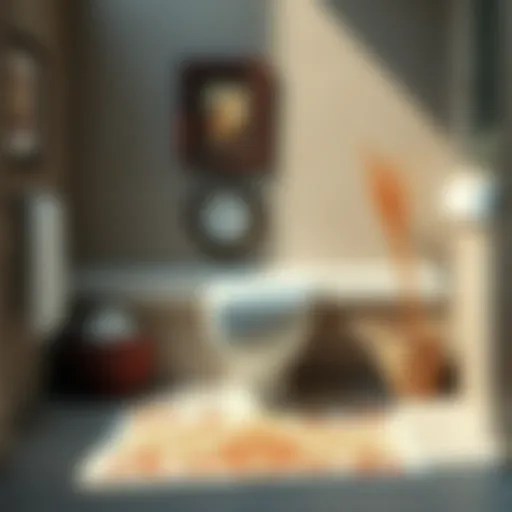Cost Analysis of Painting a Bedroom: Key Factors
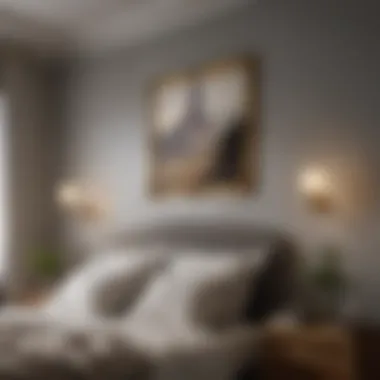
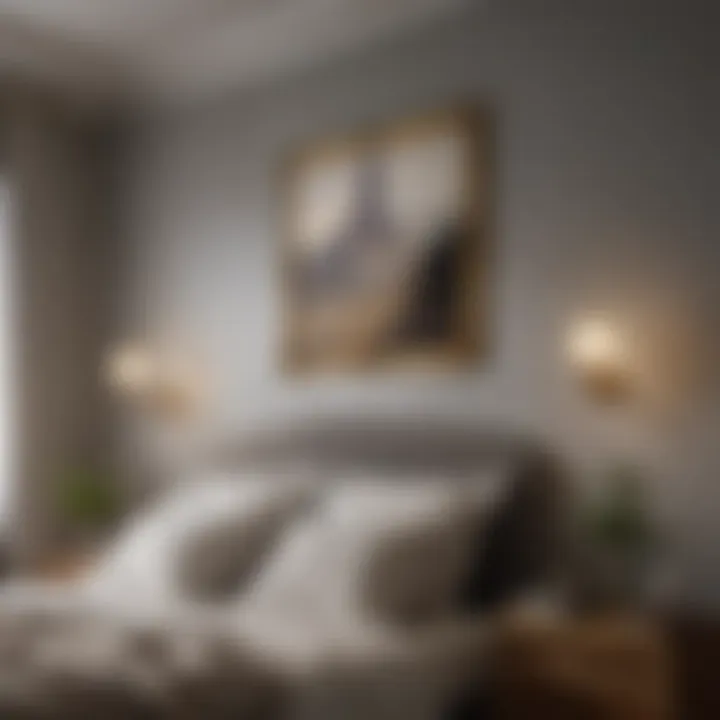
Intro
Painting a bedroom is a significant endeavor, whether you're freshening up an old space or transforming it entirely. The costs associated with this project can vary widely and depend on several key factors. Understanding these elements is crucial for effective budget management. This comprehensive guide explores the expenses involved in painting a bedroom, detailing aspects from paint prices to necessary prep work and labor considerations.
Design Inspirations
Creating an aesthetically pleasing and functional bedroom requires not just a nice coat of paint but also an understanding of current design trends.
Latest Trends in Bath and Bedroom Design
In recent years, trends have shifted towards creating serene, cozy environments. Soft, earthy tones have gained popularity, often providing a backdrop for natural materials. Textured surfaces and feature walls are also becoming common.
Color Palettes and Themes
Choosing a color palette is one of the most exciting parts of the painting process. Consider the mood you want to create: calm, energizing or even romantic. Popular themes include:
- Neutral tones like grays and beiges create a calm environment.
- Bold colors such as deep blues and rich greens can make a statement and add drama.
- Pastels offer a timeless feel, suitable for both classic and modern settings.
- Monochromatic schemes provide a unified look that’s both chic and modern.
Functional Elements
While aesthetics matter, functionality is equally important. The right paint job can significantly affect how a space feels and operates.
Space Optimization Tips
A well-thought-out color choice can visually expand a smaller bedroom or enhance an expansive one. Light colors make a room feel larger, while darker colors can create an intimate atmosphere. Additionally, utilizing mirrors in the room can reflect color and light, making the space feel more open.
Multi-Functional Furniture Choices
In today’s fast-paced living, multi-functional furniture is a smart option. Pieces like a bed frame with storage or desks that can fold into the wall maximize space and keep the room organized. This approach allows the paint job to enhance both the beauty and usability of the bedroom.
"An effective color scheme can enhance usability and transform your bedroom into a space that reflects your lifestyle and preferences."
In summary, the cost analysis of painting a bedroom includes various elements from design inspirations to functionality. Homeowners should factor in their preferences and budget to achieve the best results. The painted surface not only serves as a backdrop for the room but also elevates the overall ambiance and functionality.
Understanding Paint Costs
Understanding the costs associated with painting a bedroom is crucial for anyone planning this task. This topic encompasses various elements that directly influence the overall budget. Knowing these factors allows homeowners to manage expenses effectively and choose materials wisely.
When approaching a painting project, a clear grasp of paint costs can prevent overspending. It also ensures that the right type of paint and application methods are chosen, aligning with the desired outcomes.
Furthermore, understanding these costs provides insights into quality variations between products. Homeowners will appreciate knowing how factors such as paint quality and brand reputation contribute to the final costs, thus allowing them to make informed purchasing decisions. Below is a detailed examination of these aspects that shape paint costs.
Prelims to Bedroom Painting
Painting a bedroom is more than merely refreshing a space. It influences the room's ambiance and can add value to a home. However, the cost of painting a bedroom is often a prime consideration for many.
Before diving into the actual task, it's essential to understand the specific requirements of the project, including paint types, necessary tools, and potential labor expenses. This initial planning stage can significantly impact the overall cost efficiency of the project. Moreover, grasping the essentials of bedroom painting aids in avoiding common pitfalls that could inflate costs unnecessarily.
Factors Influencing Paint Prices
The prices of paint can vary significantly based on several factors. Recognizing these can help prioritize spending in a way that maximizes value.
Quality of Paint
The quality of paint is a pivotal aspect when considering costs. High-quality paint typically costs more, yet it often provides better coverage and durability. This means fewer coats may be needed, ultimately saving time and money in the long run.
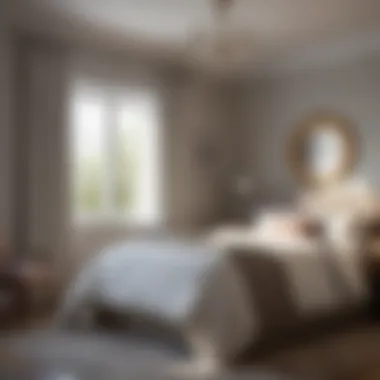
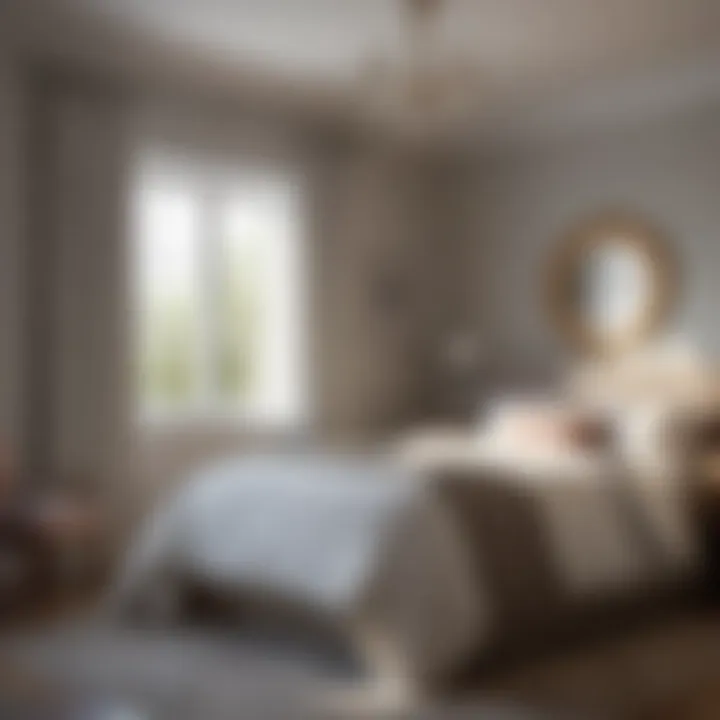
A key characteristic of quality paint is its formulation, which can impact how well it adheres to surfaces and withstands wear and tear. Therefore, investing in a reputable quality paint can be seen as a beneficial choice for anyone looking for lasting results.
Brand Reputation
Brand reputation plays a significant role in paint pricing. Well-known brands often command higher prices due to their proven reliability and product performance. Consumers may gravitate towards brands like Sherwin-Williams or Benjamin Moore because these companies have established trust over time.
Unique features of reputable brands include consistent quality, extensive color ranges, and robust customer service. While opting for cheaper, lesser-known brands might seem economical, it could lead to disappointing results that require further investment down the line.
Color Selection
Color selection impacts paint prices, as some colors may be more expensive due to the pigments used. Additionally, certain colors might not cover as well, necessitating the purchase of more paint. This can lead to unplanned expenditures in what was originally a well-budgeted project.
A key feature of color selection is its influence on mood and perception in a room. Choosing the right color can enhance the aesthetics of a bedroom, making it feel more inviting. Conversely, poor color choices can result in unsatisfactory results and additional costs for repainting.
Understanding these factors helps in not only budgeting but also ensuring the desired outcome is achieved without overspending.
Calculating the Amount of Paint Needed
Calculating the amount of paint needed is a critical step in any painting project. This process impacts budgeting, reduces waste, and ensures the project runs smoothly. Getting an accurate assessment of paint quantity needed prevents unnecessary costs and time delays that might occur if you underestimate the amount required. The two key elements here are measuring your bedroom dimensions and estimating coverage per gallon.
Measuring Your Bedroom Dimensions
Wall Area Calculation
Wall area calculation involves determining the total area of the walls you plan to paint. It is essential because it directly influences how much paint will be needed for the job. To calculate wall area, you multiply the height of each wall by its width. For a typical room, this means measuring one wall at a time and then using the formula:
Total Wall Area = Height x Width
This approach is helpful as it is straightforward and easy to understand. A benefit of a precise wall area calculation is that it helps avoid purchasing excess paint, which is wasteful. The drawback, however, is that it requires careful measurement. If there is a mistake in measurement, it can lead to either a shortage or an overabundance of paint. Therefore, double-checking all measurements is advisable.
Ceiling Considerations
Ceiling considerations, while often overlooked, play a significant role in the overall painting project. The ceiling also requires paint, and its area should be factored into the total calculations. Typically, to find the ceiling area, you can use the same principles as wall area calculation, multiplying the length and width of the room.
Understanding the specific requirement for the ceiling can yield various benefits. For example, if the ceiling height is different from the walls, adjustments must be made to ensure proper coverage. However, one major consideration is whether to paint the ceiling the same color as the walls or a different shade entirely; this may influence the overall appearance of the room and potentially the quantity of paint needed.
Estimating Coverage Per Gallon
Estimating coverage per gallon is integral to the painting process. Coverage usually refers to how much area a gallon of paint can realistically cover. Most standard paints cover approximately 350 to 400 square feet per gallon. Knowing the coverage expectation helps you calculate how many gallons you will need based on the area calculated previously.
The major highlight here is that understanding standard coverage expectations assists in budgeting for the project. It helps homeowners avoid surprises in costs. A potential downside is that coverage can vary due to a host of factors, including the texture of the walls, the method of application, and the color of the paint itself. Misjudging any of these might lead to underestimation.
Variability with Different Paints
Variability with different paints is another important aspect to consider. Not all paints offer the same coverage; some specialty paints might only cover around 250 square feet per gallon. This property can drastically change the overall amount you need, especially if you shift from a standard paint option to a specialty variant.
Understanding this variability is essential. It revises and contextualizes earlier calculations. A unique feature of this aspect is the difference in formulation and its impact. While higher-end paints may have better coverage and durability, they can also be more expensive. Thus, evaluating cost versus coverage effectively ensures that your painting project remains within budget while achieving desired results.
Types of Paint and Their Costs
Understanding the types of paint and their costs is crucial for anyone considering a bedroom painting project. Different paints carry varying price points that depend on their composition, finish, and features. By selecting the right type of paint, one not only meets aesthetic preferences but also ensures durability and maintenance convenience in the long run. An informed choice can lead to significant savings and a more satisfying end result.
Interior Paint Varieties
Flat vs. Satin vs. Gloss Finish
When discussing the finishes—flat, satin, and gloss—it is important to note that each has unique characteristics that influence both visual outcome and practicality. Flat finishes have a matte appearance, making them ideal for concealing imperfections on walls. They do not reflect much light, and they are often the least expensive option. However, they may not be washable and could require more frequent touch-ups.


On the other hand, satin finishes offer a subtle sheen and are more washable than flat finishes. They strike a balance between aesthetics and functionality, making them a popular option for bedrooms. Gloss finishes provide high reflectivity and durability. They are the most resistant to stains and moisture, suitable for areas needing frequent cleaning.
Choosing between these finishes should depend on the wall conditions and the expected wear. While gloss may be less suitable for a cozy bedroom atmosphere compared to satin, it has clear advantages in terms of maintenance.
Eco-Friendly Options
As awareness around environmental issues increases, eco-friendly paint options have gained traction. These paints typically have low or no volatile organic compounds (VOCs), which contributes to improved air quality. The key characteristic of eco-friendly paints is their ability to reduce toxic emissions. This makes them an attractive choice for those who are health-conscious or have children.
While eco-friendly paints can sometimes be more expensive than conventional options, many users find the benefits worth the investment. Their unique feature includes a limited environmental impact and healthier indoor air quality, aligning with a growing mindful lifestyle. Some ecologically-conscious consumers may choose these paints despite the higher upfront costs.
Specialty Paints
Textured Paints
Textured paints offer a distinctive option for enhancing the tactile quality of walls. These paints are a blend of traditional paint with additives that create a textured finish. They can help disguise imperfections and add depth to a room's overall appearance. One of the key characteristics that make textured paints appealing is their ability to elevate a standard wall into a statement piece.
However, they do require more effort for application, as the techniques used to apply them may vary considerably from standard paint styles. In terms of maintenance, textured surfaces can collect dust and dirt, which may lead to a more challenging cleaning process. Still, many homeowners appreciate the unique aesthetic and opt for textured solutions for a more personalized space.
Washable and Stain-Resistant Paints
Washable and stain-resistant paints are becoming increasingly popular choices for those seeking durability. These paints often contain additives that help resist stains, making them ideal for high-traffic areas. The key characteristic of these paints is their ease of cleaning, allowing for simple maintenance without compromising appearance.
These paints often come with a higher price tag compared to regular options, but their longevity and ease of upkeep can offer significant long-term cost benefits. They are perfect for bedrooms, particularly where children or pets are concerned. Homeowners may find they save money over time due to increased durability and lower touch-up needs.
In summary, carefully evaluating the type of paint required based on factors like finish, environmental impact, and specialty attributes can lead to better decisions. Every paint choice affects not just cost but also the overall aesthetics and livability of a space.
Cost Breakdown of Painting a Bedroom
Understanding the cost breakdown of painting a bedroom is essential for anyone planning to undertake this project. It provides a detailed insight into all the components that contribute to the total expense. This section will help homeowners budget effectively, ensuring they are not caught off guard by unexpected expenditures.
Total Paint Costs
Calculating Paint Expenses
Calculating paint expenses involves assessing the amount of paint required and its cost based on current market prices. It is a crucial step in developing a budget. Knowing how much paint to buy will ultimately influence the overall project cost. One of the key characteristics of calculating paint expenses is the understanding of square footage. By measuring the bedroom walls and ceiling, one can derive an accurate estimate. A benefit of calculating paint expenses is that it helps to avoid over- or under-buying paint, which can waste money.
Another unique feature is that paint costs may vary based on seasonal discounts and promotions. This fluctuation can result in significant savings for the cost-conscious homeowner. However, careful calculation is essential to prevent financial discrepancies during the project.
Comparing Different Paint Brands
Comparing different paint brands is vital because it allows consumers to identify the best quality for their budget. Each brand offers various qualities and corresponding price points. One key characteristic of this comparison is the balance between cost and durability. For example, while a premium brand may have a higher upfront cost, it can save money in the long run due to its longevity and fewer coats needed for adequate coverage.
The unique feature of comparing different paint brands is that it provides insight into customer reviews and performance ratings. Checking these can be useful in preventing dissatisfaction after purchasing. However, brand loyalty can sometimes skew decision-making, leading to an expensive choice that might not be necessary for every project.
Additional Materials and Supplies
To ensure a quality paint job, it is not just about the paint itself; additional materials and supplies play an important role. These items contribute to the overall success of the project and need to be included in the budget.
Brushes and Rollers
Choosing the right brushes and rollers can enhance the painting experience and result in a better finish. Their importance lies in their ability to apply paint smoothly and evenly. A key characteristic here is the material of the brush or roller. Synthetic materials work well with water-based paints, while natural materials are suitable for oil-based products.
A significant advantage of investing in high-quality brushes and rollers is the durability they offer. Cheaper options may breakdown quicker, leading to a need for replacements during the project. This can increase costs unexpectedly. Therefore, the initial investment in superior tools can pay off by providing a more efficient and enjoyable painting experience.
Drop Cloths and Tape


Drop cloths and tape are essential for protecting areas that should not be painted. They help in maintaining cleanliness while painting, which prevents costly cleanup later. One prominent feature is that drop cloths come in various materials, such as canvas or plastic, each with their benefits. Plastic is affordable but may slip on floors, while canvas is more stable but costs more.
Tape is critical for achieving clean edges and preventing bleed-through. The quality of the tape can influence how well it adheres to surfaces, directly affecting the finish of the paint job. A consideration when choosing tape is whether it is easy to remove without damaging walls or trim. High-quality options often come with a higher price tag but can save time in touch-ups post-painting.
"A detailed cost breakdown ensures no expense is overlooked, leading to a smoother painting project experience."
In summary, a thorough cost breakdown is central to anyone looking to paint a bedroom. It encompasses paint costs, materials, and tools, giving a clear financial picture of what to expect. This careful planning enables homeowners to achieve their desired results without overspending.
Labor Costs and DIY vs. Professional Services
Understanding labor costs is critical when planning to paint a bedroom. The choice between doing it yourself and hiring professionals can significantly influence your budget and the quality of the final outcome. Each option presents unique benefits and drawbacks, which should be thoroughly considered.
DIY Painting Considerations
Skill Level Assessment
Assessing your skill level is an important first step when considering DIY painting. This assessment helps gauge your ability to effectively manage the painting project. A key characteristic of this evaluation is recognizing your previous painting experience. Whether you have painted before or are a complete novice can affect the outcome. Choosing the DIY route might be beneficial for those willing to learn.
Unique features of skill level assessment include the opportunity to enhance paint application techniques. A self-initiated painting project provides a practical platform for developing skills. However, it’s crucial to accept limitations. A lack of experience can lead to oversights that might increase costs later. Proper assessment promotes informed decisions that align your capabilities with project expectations.
Time Investment
The time investment required for painting is another aspect to consider. DIY projects typically demand considerable time commitment. Planning sufficient hours for preparation, painting, and drying is essential, as these steps can extend over several days. A significant characteristic of time investment in DIY jobs is the flexibility it offers. Homeowners can paint at their own pace, fitting it around their schedules.
A unique feature of time investment is how it allows workers to adjust their approach. For instance, if unforeseen issues arise, such as a need for extra coats or surface repairs, it is easier to adapt timelines. However, the time cost must also be considered; the lack of professional speed can lead to delays. By weighing time investment against budgetary concerns, individuals can strategically plan their approaches.
Hiring Professional Painters
Cost Estimation
Cost estimation in the context of hiring professional painters is essential for budget preparation. Understanding the potential expenditure related to this choice provides clarity before moving forward. A prominent characteristic of cost estimation is its detailed nature. Professionals typically assess the scope of the work, taking various factors like room size and paint selection into account.
Cost estimation also includes labor fees, which can vary significantly by region and expertise. A transparent estimation process allows for better budgeting, ensuring no hidden fees emerge later. However, the downside is that professional services may exceed initial expectations, making it vital to seek multiple quotes to find appropriate pricing.
Evaluating Professional Services
Evaluating professional painting services can feel daunting but is necessary for informed decisions. This evaluation often involves examining past work portfolios and reviews. A significant characteristic of this process is its focus on reliability. Established professionals often have significant experience and can deliver better quality results, saving money in the long run.
The unique feature of evaluating these services lies in the comparison of multiple contractors. Discussions about previous projects can provide insights into the level of service offered. However, a disadvantage could be the overwhelming number of options. Ensuring that you find a reputable painter allows you to mitigate risks associated with hiring incorrect services.
Finishing Touches and Maintenance
The final phase of painting a bedroom is vital for both aesthetic appeal and longevity. Finishing touches and maintenance ensure the paint job remains attractive and durable over time. This section examines essential considerations like post-painting maintenance, emphasizing its importance in enhancing the quality and lifespan of the paint job.
Post-Painting Maintenance
Post-painting maintenance can significantly affect how well a room looks over time. Proper care not only preserves the finish but also minimizes the need for frequent repainting. Homeowners must engage in regular inspectiion and upkeep activities.
Cleaning and Touch-Ups
Cleaning and touch-ups play essential roles in the overall maintenance of painted surfaces. Small scuffs or marks can diminish the room’s appearance. Regular cleaning helps maintain surface integrity by preventing dirt accumulation. Using a gentle cleaner or a damp cloth can help in keeping walls looking fresh.
When it comes to touch-ups, matching paint color is crucial for a seamless look. One unique feature of this practice is that it allows homeowners to refresh their rooms without a full repaint. This method is often favored because it is cost-effective and less labor-intensive. That said, careful attention is needed to ensure the touch-ups do not alter the texture or sheen of the existing paint.
Longevity of Paint Jobs
The longevity of paint jobs can be influenced by several factors, including paint quality and environmental considerations. Higher quality paints typically result in longer-lasting finishes. Additionally, certain environmental elements like humidity and sunlight exposure can affect durability.
A distinctive trait of focusing on longevity is that homeowners can save money in the long run. By investing in quality materials and maintaining them properly, the frequency of repainting can decrease. However, it is vital to remember that neglect can lead to peeling and fading over time.
Regular maintenance is key to ensuring that your paint job maintains its vibrancy and durability for years to come.
In summary, finishing touches and maintenance offer essential benefits to a painted bedroom. Cleaning and touch-ups preserve the initial work, while attention to longevity minimizes future expenses. A proactive approach ensures that the investment in painting remains worthwhile.





